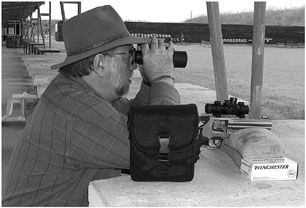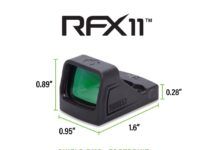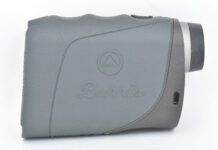
Good optics should be able to put the outdoor enthusiast up close and personal with fur, feather, and fauna to increase his enjoyment of the great outdoors, or to help the shooter see what’s going on downrange. A quality pair of binoculars can be one of the best tools carried by hunters, and they are convenient, lightweight spotters for checking out short-range groups and reading wind and mirage for the rifle and pistol shooter.
In many cases, expense is no object when looking for the perfect pair of binoculars for your particular pastime. However, as we found in our field test, price is not always the determining factor in how binoculars do their jobs.
In this two-part test, six models of binoculars were put into service. All of the models were 10X42, which means the image is magnified 10 times, and the objective lens diameter is 40mm, which determines the amount of light reaching your eyes. The retail price range for the six binoculars runs from $260 up to $1,700. The brands included three German-made binoculars — the Zeiss Victory FL, Leica Ultravid, and Steiner Peregrine; two models made in Japan — the Leupold Wind River Pinnacle and the Bushnell Legend; and one from Austria — the Swarovski SLC.
We acquired all the products from SWFA, 420 Century Way, No. 100, Red Oak, TX 75154; (972) SCOPE-IT (726-7348), www.swfa.com. All the prices listed for the glasses are SWFA’s current retail prices.
SWFA’s Chris Farris said, “Choosing the best binocular for your needs isn’t always easy. Consider when, where and how often you plan to use them in order to select a binocular with a combination of features that is right for you.”
To cover a variety of situations where binoculars would be a valuable tool, we selected several test objects or targets that were placed at various ranges. We had a pool of examiners gauge the glasses on a range of subjective areas, in field tests that reflected how the glasses might be used. In one test, we put out two stuffed quail in the brush at 30 yards and at 100 yards. Color and brightness of the image were the test factors for the stuffed bird test.
To judge the models’ service during a deer hunting situation, a life-sized target and a mounted set of antlers were placed at 100 yards. Brightness and clear view of the full-body image were test factors, and the antlers presented an interesting twist to the view ranking. Although the rack appeared to be a typical 10-point whitetail deer, an eleventh point — this one with its own base — stuck out about an inch from the bottom of the right-hand side of the antlers. Picking out the extra point was the tiebreaker in this test.
In a long-distance test, a metal deer blind was examined with all the models at a distance of 400 yards to determine how many details could be observed.
And on a shooting range, we placed various eye charts and shot targets to see how well paper could be read by the recreational shooter. Members of our group who wear prescription glasses tested the models both with and without eyewear. Here is our report:
[PDFCAP(1)]
At the low end of the price list was the Bushnell 10X42 Legend Binoculars Model 130142. The model is made in Japan, and U.S. consumers can contact the company at (800) 423-3537, www.bushnell.com. Despite the low price tag of this model, our testers were impressed with the solid grip and ease of handling of this pair of binoculars. The weight of the model, 29.8 ounces, seemed to be well distributed and provided a solid viewing platform. Focus and eye relief adjustments were simple, making this model easy to use.
Where the higher-end models would offer a bright, clear view of the test items at all ranges, the view was slightly less sharp with this pair. At close range, the eyes of the stuffed quail could be seen with clear detail, but the color of the feathers did not stand out. In the 100-yard test, the eleventh point on the rack was fuzzy and would not have allowed members of our test group to be confident of taking a shot at the deer. The life-sized target was clearly visible, although details were not as sharp as we would have liked. Character recognition on charts at longer distances was noticeably less accurate. As with the other low-end model, the long-range view of the deer blind was acceptable but not impressive.
[PDFCAP(2)]
The Leupold Wind River 10X42 Pinnacle Binoculars Model R54514 are made in Japan. Contact the company at (503) 526-1400 or www.leupold.com.
Tied for the lightest model, this compact pair of binoculars weighed just 25 ounces and was very easy to use. It offered a quality image at all ranges. The quickly adjustable eye cups were a surprising feature for the bargain-priced optics. Unlike some of the high-dollar models, switching from using the optics with eyeglasses to without eyeglasses was very simple. Although the views of our test items were clear at all ranges, the images were not as bright as the other models, our testers said.
The eleventh point on the rack was visible, but was not as clear as our testers would have liked. In the long range test, our group could tell we were looking at a deer blind, but the features of the blind were not crystal clear, and letters and groups sizes at the range weren’t crisp, in our opinion. Handling ability with the thumb groves and ease of adjusting interpupillary distance received high marks. In addition, our group liked the feel of the model’s elastic carry strap.
[PDFCAP(3)]
The lowest priced of our three German products in the group was the Steiner 10X42 Peregrine Binoculars No. 358. The contact in the United States is Steiner Pioneer Research, (800) 257-7742, www.steiner-binoculars.com.
Unlike all the other models, the lens covers on the Steiner binoculars were permanently attached and always seem to be closed or flapping in the wind. Maybe a minor point, but none of our test group was happy with having to deal with this feature.
While the quality of images at both short and long ranges was very good, the field of view through the extended eyecups was much larger when the user is not wearing eye glasses. The cups can be folded down out of the way, but once again, this feature drew lower marks from the test group.
The armored covering on the model was a little too slick for our touch, but the ridges on the top of the model provided a good feel. Weighing just 25 ounces, the Steiners were light enough not be feel like a boat anchor around your neck.
Overall, because of the concerns about handling features and the disappointment in the image quality of this high-end model, our test group was less than enthusiastic about these binoculars. We did like the hard-cover case and the way it holds the binoculars in a separate pocket.
Gun Tests Recommends
• Leupold Wind River 10X42 Pinnacle Binoculars Model R54514, $400. Buy It. Low price and quality performance are a winning combination for this model.
• Bushnell 10X42 Legend Binoculars Model 130142, $260. Conditional Buy. Probably as good as could be expected for the price, the quality of images at all ranges was not as good as the Wind River set.
• Steiner 10X42 Peregrine Binoculars No. 358, $900. Conditional Buy. Our testers were not happy with the lens covers that flopped down and seemed to always be in the way, and with the eyecups that had to be folded down rather than twisted into place like the other models. However, images at all ranges were good to excellent.




























